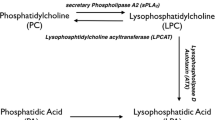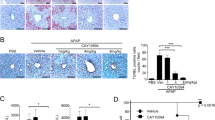Abstract
Effects of GTP-binding proteins on the activation of secretory phospholipase A2 (sPLA2) and cytosolic phospholipase A2 (cPLA2) in rat liver during two different phases of sepsis were studied. Sepsis was induced by cecal ligation and puncture (CLP). Experiments were divided into three groups: control, early sepsis, and late sepsis. Early and late sepsis refers to those animals sacrificed at 9 and 18 h, respectively, after CLP. The results show that in the absence of G-protein modulator, hepatic sPLA2 and cPLA2 activities were activated by 40.8-46 and 91.6-105.8%, respectively, during early and late phases of sepsis. GTPγS and fluoroaluminate (A1F4-) stimulated sPLA2 and cPLA2 activities within each experimental group, i.e., control, early sepsis, and late sepsis. The GTPγS and A1F4--stimulated sPLA2 and cPLA2 activities remained significantly elevated during early phase (22.3-65.6% increase) and late phase (32.5-109.1% increase) of sepsis. Further analyses demonstrate that cholera toxin significantly stimulated sPLA2 and cPLA2 activities within each experimental group, and that the cholera toxin stimulated sPLA2 and cPLA2 activities remained significantly higher during early phase (23.5-37%increase) and late phase (56.7-70% increase) of sepsis. In contrast, pertussis toxin significantly inhibited sPLA2 and cPLA2 activities within each experimental group, and that the pertussis toxin-inhibited sPLA2 and cPLA2 activities remained significantly higher in early septic (57-68.5% increase) and late septic (34.6-45.5% increase) experiments. These data demonstrate that cholera toxin-sensitive Gαs and pertussis toxin-sensitive Gαi were both involved in the activation of sPLA2 and cPLA2 activities in rat liver during the progression of sepsis.
Similar content being viewed by others
References
Roberts MF: Phospholipases: Structural and functional motifs for working at an interface. FASEB J 10: 1159–1172, 1996
Van Bilsen M, Van der Vusse GL: Phospholipase‐A2‐dependent signaling in the heart. Cardiovasc Res 30: 518–529, 1995
Liu MS: Mechanism of myocardial membrane alterations in endotoxins shock: Roles of phospholipase and phosphorylation. Circ Shock 30: 43–49, 1990
Vadas P, Pruzanski W: Induction of group II phospholipase A2 expression and pathogenesis of sepsis syndrome. Circ Shock 39: 160–167, 1993
Guidet B, Piat O, Masliah J, Barakett V, Maury E, Bereziat G, Offenstadt G: Secretory nonpancreatic phospholipase A2 in severe sepsis: Relation to endotoxin, cytokines and thromboxane B2. Infection 24: 103–108, 1996
Anderson BO, Moore EE, Braerjee A: Phospholipase A2 regulates critical inflammatory mediators of multiple organ failure. J Surg Res 56: 199–205, 1994
Vadas P, Hay JB: Involvement of circulating phospholipase A2 in the pathogenesis of the hemodynamic changes in endotoxin shock. Can J Physiol Pharmacol 61: 561–566, 1983
Liu M. S, Xuan YT: Mechanism of endotoxin‐induced impairment in Na+‐Ca2+ exchange in canine myocardium. Am J Physio1 251: R1078‐R1085, 1986
Liu MS, Wu LL: Heart sarcolemmal Ca2+ transport in endotoxin shock: II. Mechanism of impairment in ATP‐dependent Ca2+‐transport. Mol Cell Biochem 112: 135–142, 1992
Wu LL, Liu MS: Altered ryanodine receptor of canine cardiac sarcoplasmic reticulum and its underlying mechanism in endotoxin shock. J Surg Res 53: 82–90, 1992
Cerra FB: Multiple organ failure syndrome. In: DJ Bihari and FB Cerra (eds). Multiple organ failure. Fullterton, CA: Soc Crit Care Med, 1989, pp 1–24
Tong LJ, Dong LW, Hsu HK, Liu MS: Phospholipase A2 activities are decreased during early but increased during late phases of sepsis in rat heart. J Surg Res 75: 165–169, 1998
Dong LW, Yang J, Tong LJ, Hsu SK, Liu MS: Group II phospholipase A2 gene expression is transcriptionally regulated in rat liver during sepsis. Am J Physiol 273: G706–G712, 1997
Axelrod J: Phospholipase A2 and G proteins. Trends Neurosci 18: 64–65, 1995
Burch RM, Luini A, Axelrod J: Phospholipase A2 and phospholipase C are activated by distinct GTP‐binding proteins in response to alpha1‐adrenergic stimulation in FRTL5 thyroid cells. Proc Natl Acad Sci USA 83: 7201–7205, 1986
Ando M, Furui H, Suzuki K, Taki F, Takagi K: Direct activation of phospholipase A2 by GTP binding protein in human peripheral polymorphonuclear leukocytes. Biochem Biophys Res Commun 183: 708–713, 1992
Dickerson CD, Weiss ER: The coupling of pertussis toxin‐sensitive G proteins to phospholipase A2 and adenylyl cyclase in CHO cells expressing bovine rhodopsin. Exp Cell Res 216: 46–50, 1995
Jelsema CL, Axelrod J: Stimulation of phospholipase A2 activity in bovine rod outer segments by the beta gamma subunits of transducin and its inhibition by the alpha subunit. Proc Natl Acad Sci USA 84: 3623–3627, 1987
Kruger H, Carr S, Brennand JC, McLean JS: Activation of phospholipase A2 by the human endothelin receptor in chinese hamster ovary cells involves Gi protein‐mediated calcium influx. Biochem Biophys Res Commun 217: 52–58, 1995
De Boland AR, Morelli S, Boland R: 1,25(OH)2‐Vitamin D‐3 stimulates phospholipase A2 activity via a guanine nucleotide‐binding protein in chick myoblasts. Biochim Biophys Acta 1257: 274–278, 1995
Sa C, Fox PL: Basic fibroblast growth factor‐stimulated endothelial cell movement is mediated by a pertussis toxin‐sensitive pathway regulating phospholipase A2 activity. J Biol Chem 269: 3219–3225, 1994
Iorio P, Grtesele P, Stasi M, Nucciarelli F, Vezza R, Nenci GG, Goracci G: Protein kinase C inhibitors enhance G‐protein induced phospholipase A2 activation in intact human platelets. Febs Lett 381: 244–248, 1996
Cockcroft S: G‐protein‐regulated phospholipase C, D and A2‐mediated signalling in neutrophiles. Biochim Biophys Acta 1113: 135–160, 1992
Wichterman KA, Baue AE, Chaudry IH: Sepsis and septic shock: A review of laboratory models and a proposal. J Surg Res 29: 189–201, 1980
Hwang TL, Lau YT, Chen MF, Tang C, Liu MS: Biphasic intracellular redistribution of α?in???adrenergic receptors in rat liver during sepsis. Am J Physiol 265: R385–R391, 1993
Katsumata M, Gupta C, Goldman AS: A rapid assay for activity of phospholipase A2using radioactive substrate. Annal Biochem 154: 676–681, 1986
Lin LL, Wartmann M, Lin AY, Knopf JL, Seth A, Davis RJ: cPLA2 is phosphorylated and activated by MAP kinase. Cell 72: 269–278, 1993
Lowry OH, Rosebrough NJ, Farr AL, Randall RJ: Protein measurement with the Folin phenol reagent. J Biol Chem 193: 265–275, 1961
Axelrod J: Receptor‐mediated activation of phospholipase A2 and arachidonoc acid release in signal transduction. Biochem Soc Trans 18: 503–507, 1990
Ma H, Weiss CA: In vitro analysis of G‐protein functions. Methods Cell Biol 49: 471–485, 1995
Rebois RV, Warner DR, Basi NS: Does subunit dissociation necessarily accompany the activation of all heterotrimeric G proteins? Cell Signal 9: 141–151, 1997
Hamm HE, Gilchrist A: Heterotrimeric G proteins. Curr Opin Cell Biol 8: 189–196, 1996
Nishio E, Nakata H, Arimura S, Watanabe Y: α1‐adrenergic receptor stimulation causes arachidonic acid release through pertussis toxinsensitive GTP‐binding protein and JNK activation in rabbit aortic smooth muscle cells. Biochem Biophys Res Commun 219: 277–282, 1996
Insel PA: Adrenergic receptors, G proteins, and cell regulation: Implications for aging research. Exp Gerontol 28: 341–348, 1993
Perez DM, Deyoun MB, Graham PM: Coupling of expressed α1B‐and α1D‐adrenergic receptors to multiple signaling pathways in both G protein and cell type specific. Mol Pharmacol 44: 784–795, 1993
Author information
Authors and Affiliations
Rights and permissions
About this article
Cite this article
Tong, LJ., Dong, LW. & Liu, MS. GTP-binding protein mediated phospholipase A2 activation in rat liver during the progression of sepsis. Mol Cell Biochem 189, 55–61 (1998). https://doi.org/10.1023/A:1006804429027
Issue Date:
DOI: https://doi.org/10.1023/A:1006804429027




